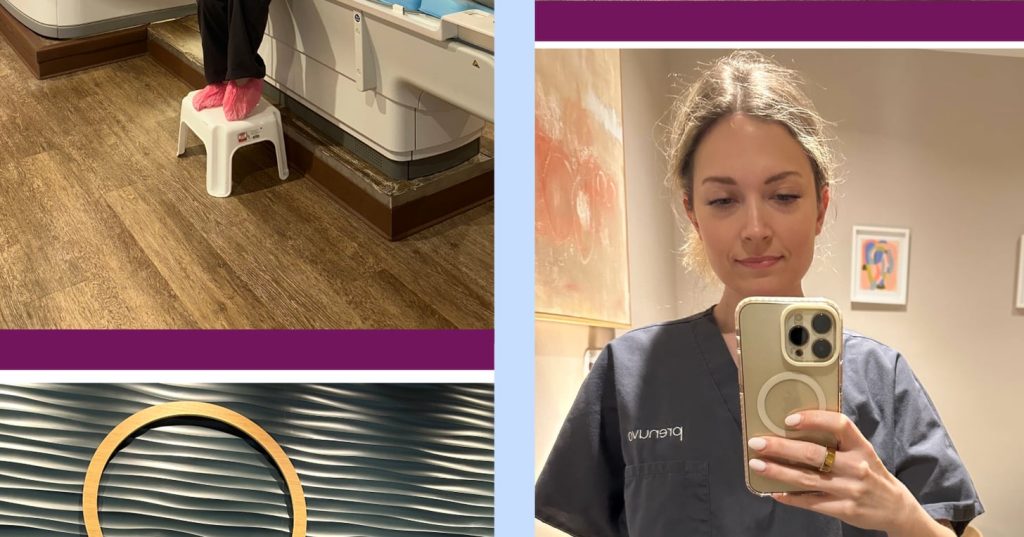
As a longtime editor and writer in the health and wellness space, there’s not much I won’t try. So, when I had the chance to test out Prenuvo, I couldn’t turn down the chance to see what the hype was all about.
Prenuvo is a preventative full-body MRI, which is a scan that uses magnets and radio waves to create images of your body. Typically, a doctor has to order an MRI when a patient is experiencing discomfort or believes something is wrong. The aim behind Prenuvo, however, is to find issues before they even cause symptoms, ideally catching diagnoses — like cancer, for example — in early stages before a progression into something more serious.
With the new focus on preventative healthcare, Prenuvo is an example of medical tests that are optional or elective . . . and therefore not covered by insurance. While getting ahead of a potential life threatening issue seems priceless, it’s hard to ignore the $2,500 price tag on the Prenuvo scan.
Even so, there’s a growing number of celebrities and content creators posting about it, including Kate Hudson and Maria Menuenos, who discovered a pancreatic cancer diagnosis after her Prenuvo scan. So, is it worth taking the leap if you can afford it? Here’s more on my experience. Plus, a doctor weighs in on the pros and cons.
Experts Featured in This Article
Shoshana Ungerleider, MD, is a board-certified internal medicine physician and founder of End Well Foundation.
What Is a Prenuvo Full-Body Scan?
“A full-body scan typically refers to an imaging procedure, often using MRI technology, that examines multiple parts of the body in one session,” says internal medicine physician Shoshana Ungerleider, MD. “Unlike targeted imaging, such as a mammogram or CT scan of the lungs, these scans aim to capture a broad view of your body, including your organs, tissues, and sometimes blood vessels.”
Full-body scans are not usually performed in a standard medical practice, so you typically have to visit a designated imaging clinic, but the purpose is to detect early signs of abnormalities before symptoms arise. “A full-body scan may be able to detect structural abnormalities throughout the body, such as tumors, both benign and malignant, cysts or fluid collections, signs of inflammation, and even certain chronic conditions, but it can also identify vascular irregularities, such as aneurysms,” Dr. Ungerleider says.
“However, it’s worth noting that these scans primarily focus on structural changes [in the body] and do not typically provide functional or metabolic insights, which are often crucial for a more comprehensive diagnostic evaluation,” Dr. Ungerleider adds. As a result, any findings from a full-body scan often require follow-up testing to determine their clinical significance, since not all detected abnormalities are harmful or require intervention.
What the Prenuvo Scan Was Like
I’ve never had an MRI, at least that I can remember, and definitely not a full-body MRI. I was a bit anxious before the scan for two reasons: First, I wasn’t sure if I’d get claustrophobic in the machine, since you have to stay still for about an hour. (You can ask for a sedative if you have severe anxiety or claustrophobia, but I decided to forgo it.) Second, I was slightly unnerved by what the scan could find. I remember reading Jason Tartick’s Instagram post about his experience with the scan finding a lung nodule, and thinking how anxious I’d be if the scan found something similar or worse.
When it comes to health, I believe knowledge is power, but sometimes ignorance seems like bliss when you have health anxiety. That said, I’d rather be empowered with information than regret not having the chance to potentially catch something early.
When I arrived at Prenuvo’s NYC location, I couldn’t help but notice how it does not feel like a typical medical setting. I was required to fast for a few hours before the scan, so the receptionist asked me what snacks I’d like when it was over, and I chose a few options off a list. Then, I changed into scrubs and I headed into the room for the MRI.
I was relieved when I didn’t end up feeling too claustrophobic inside the machine, and I realized I could talk to the staff from inside the machine if I needed to get out at any point. Oh, and did I mention I also got to watch Netflix the entire time? (I chose my comfort watch, “Nobody Wants This,” naturally.)
After the scan, I got my snacks and headed home. The results came back about a week later, and I truthfully did not look at them. I needed a virtual handhold to get me through the nerves, so as soon as I got the email notification, I decided to wait to read it later when I could have my mom or sister on FaceTime with me to go through the results.
Later that evening, I opened the results with my mom on FaceTime. First, I was so impressed by the detailed images, as well as the non-triggering, non-anxiety-inducing language used throughout. Thankfully, there were no major findings but I did learn a few interesting things, like how the nagging pain in my knee is likely due to a baker’s cyst that was identified on the scan.
There were a few slightly unsettling findings that I may need to keep an eye on, but nothing that concerned me enough to seek immediate further testing. One of those findings, however, was something called a Rathke’s cleft cyst in my brain that presses on the pituitary gland. Although it sounds scary, the radiologist and doctor who reviewed my scan said it’s typically benign and not likely to grow. The cysts can, however, cause headaches, vision issues, and hormonal imbalances, which is why it’s a good idea to keep an eye on if it grows over time.
The scan also noted that I have fibrocystic, dense breast tissue. This was not news to me since I’ve had a mammogram and breast ultrasound previously after finding a lump (which I had already guessed – and now know definitively – was likely from fibrocystic tissue that can fluctuate with my hormones and menstrual cycle).
The MRI also showed a gallstone, which was surprising since I hadn’t experienced any symptoms. In fact, the results noted that 80 percent of people who have gallstones won’t ever have symptoms. Interesting! And lastly, there were small cysts found on my liver and pancreas, which the doctor assured me were benign and nothing to worry about right now.
Final Thoughts
So, is the Prenuvo scan worth it? I definitely do not regret getting the scan. Overall, I feel relieved to have had the opportunity to learn so much about my health. It’s also nice to know that I have these images saved and can share them with my doctors in the future. (They can easily see the results via the Prenuvo app on my phone.)
While I don’t think I need to get another Prenuvo scan anytime soon — I’m 32 and the brand recommends getting them yearly if you are over 40 — I would certainly plan to get another scan in a few years, especially if I have any concerns or want to check in on the prior findings. That said, the price is steep and I hope these types of tests become more affordable and accessible. The fact is, the scan is something I’d typically recommend to my own friends and family, but many won’t be able to try it unless it’s covered by insurance or becomes significantly more affordable.
The bottom line: If you are generally healthy, you probably don’t need to get a preventative MRI — but if you can afford it, and want the information it provides, then it can help give you peace of mind.
“If you’re generally healthy, without symptoms or a significant family history, the probability of finding a serious condition is very low, and current medical guidelines do not recommend full-body scans for general screening due to a lack of evidence that they improve health outcomes,” Dr. Ungerleider says. Instead, you’re better off with targeted screening tests such as a mammogram or colonoscopy, which have robust data supporting their effectiveness and are tailored to catch specific risks, she says.
— Additional reporting by Andi Breitowich








